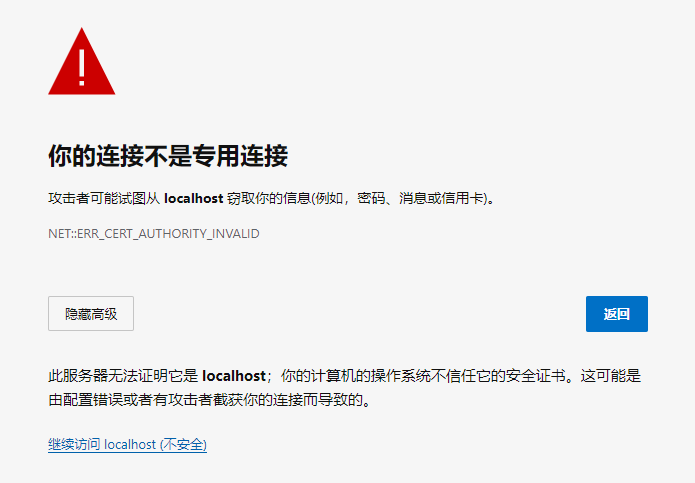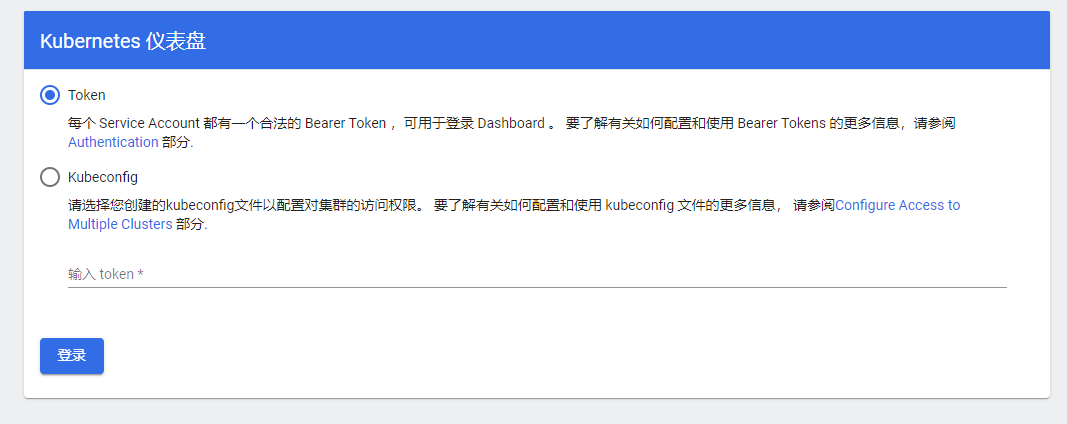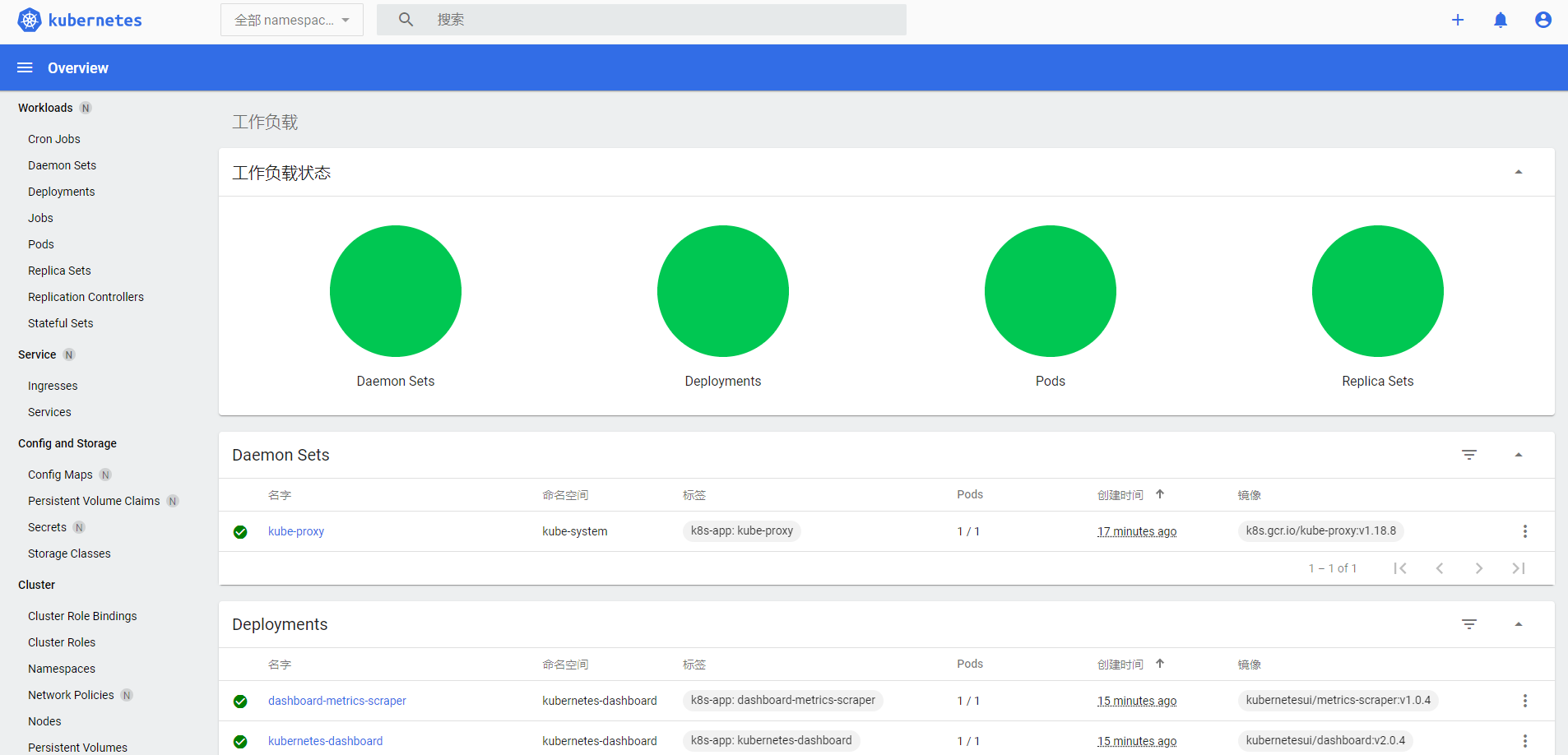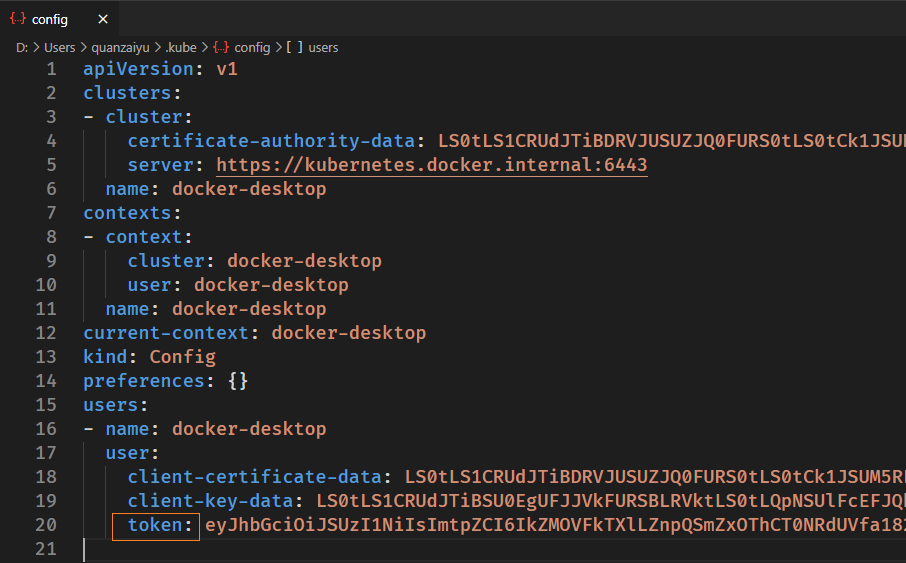一、Kubernetes Dashboard 简介
Kubernetes Dashboard是k8s的管理工具,先引用官方的文档说明:
Dashboard is a web-based Kubernetes user interface. You can use Dashboard to deploy containerized applications to a Kubernetes cluster, troubleshoot your containerized application, and manage the cluster resources. You can use Dashboard to get an overview of applications running on your cluster, as well as for creating or modifying individual Kubernetes resources (such as Deployments, Jobs, DaemonSets, etc). For example, you can scale a Deployment, initiate a rolling update, restart a pod or deploy new applications using a deploy wizard.
大意就是:
Dashboard 是基于 Web 的 Kubernetes 用户界面。您可以使用 Dashboard 将容器化应用程序部署到 Kubernetes 群集、对容器化应用程序进行故障排除以及管理群集资源。您可以使用 Dashboard 获取群集上运行的应用程序的概述,以及创建或修改单个 Kubernetes 资源(如部署、作业、守护进程集等)。例如,您可以缩放部署、启动滚动更新、重新启动窗格或使用部署向导部署新应用程序。
仪表板还提供有关群集中 Kubernetes 资源的状态以及可能发生的任何错误的信息。
下面说说如何在Docker Desktop的Kubernetes中安装。
二、获取部署文件
先到下面的链接查看最新版的Kubernetes Dashboard:https://github.com/kubernetes/dashboard/releases/
然后找到部署的yaml文件,本人安装时是使用:https://raw.githubusercontent.com/kubernetes/dashboard/v2.0.4/aio/deploy/recommended.yaml
当然,我知道大家的网络都不是太好,于是将其下载到本地,方便大家复制。以下内容修改了Service部分,修改后的文件如下:
# Copyright 2017 The Kubernetes Authors.## Licensed under the Apache License, Version 2.0 (the "License");# you may not use this file except in compliance with the License.# You may obtain a copy of the License at## http://www.apache.org/licenses/LICENSE-2.0## Unless required by applicable law or agreed to in writing, software# distributed under the License is distributed on an "AS IS" BASIS,# WITHOUT WARRANTIES OR CONDITIONS OF ANY KIND, either express or implied.# See the License for the specific language governing permissions and# limitations under the License.apiVersion: v1kind: Namespacemetadata:name: kubernetes-dashboard---apiVersion: v1kind: ServiceAccountmetadata:labels:k8s-app: kubernetes-dashboardname: kubernetes-dashboardnamespace: kubernetes-dashboard---kind: ServiceapiVersion: v1metadata:labels:k8s-app: kubernetes-dashboardname: kubernetes-dashboardnamespace: kubernetes-dashboardspec:ports:- port: 443targetPort: 8443nodePort: 30443name: kubernetes-dashboardtype: NodePortselector:k8s-app: kubernetes-dashboard---apiVersion: v1kind: Secretmetadata:labels:k8s-app: kubernetes-dashboardname: kubernetes-dashboard-certsnamespace: kubernetes-dashboardtype: Opaque---apiVersion: v1kind: Secretmetadata:labels:k8s-app: kubernetes-dashboardname: kubernetes-dashboard-csrfnamespace: kubernetes-dashboardtype: Opaquedata:csrf: ""---apiVersion: v1kind: Secretmetadata:labels:k8s-app: kubernetes-dashboardname: kubernetes-dashboard-key-holdernamespace: kubernetes-dashboardtype: Opaque---kind: ConfigMapapiVersion: v1metadata:labels:k8s-app: kubernetes-dashboardname: kubernetes-dashboard-settingsnamespace: kubernetes-dashboard---kind: RoleapiVersion: rbac.authorization.k8s.io/v1metadata:labels:k8s-app: kubernetes-dashboardname: kubernetes-dashboardnamespace: kubernetes-dashboardrules:# Allow Dashboard to get, update and delete Dashboard exclusive secrets.- apiGroups: [""]resources: ["secrets"]resourceNames: ["kubernetes-dashboard-key-holder", "kubernetes-dashboard-certs", "kubernetes-dashboard-csrf"]verbs: ["get", "update", "delete"]# Allow Dashboard to get and update 'kubernetes-dashboard-settings' config map.- apiGroups: [""]resources: ["configmaps"]resourceNames: ["kubernetes-dashboard-settings"]verbs: ["get", "update"]# Allow Dashboard to get metrics.- apiGroups: [""]resources: ["services"]resourceNames: ["heapster", "dashboard-metrics-scraper"]verbs: ["proxy"]- apiGroups: [""]resources: ["services/proxy"]resourceNames: ["heapster", "http:heapster:", "https:heapster:", "dashboard-metrics-scraper", "http:dashboard-metrics-scraper"]verbs: ["get"]---kind: ClusterRoleapiVersion: rbac.authorization.k8s.io/v1metadata:labels:k8s-app: kubernetes-dashboardname: kubernetes-dashboardrules:# Allow Metrics Scraper to get metrics from the Metrics server- apiGroups: ["metrics.k8s.io"]resources: ["pods", "nodes"]verbs: ["get", "list", "watch"]---apiVersion: rbac.authorization.k8s.io/v1kind: RoleBindingmetadata:labels:k8s-app: kubernetes-dashboardname: kubernetes-dashboardnamespace: kubernetes-dashboardroleRef:apiGroup: rbac.authorization.k8s.iokind: Rolename: kubernetes-dashboardsubjects:- kind: ServiceAccountname: kubernetes-dashboardnamespace: kubernetes-dashboard---apiVersion: rbac.authorization.k8s.io/v1kind: ClusterRoleBindingmetadata:name: kubernetes-dashboardroleRef:apiGroup: rbac.authorization.k8s.iokind: ClusterRolename: kubernetes-dashboardsubjects:- kind: ServiceAccountname: kubernetes-dashboardnamespace: kubernetes-dashboard---kind: DeploymentapiVersion: apps/v1metadata:labels:k8s-app: kubernetes-dashboardname: kubernetes-dashboardnamespace: kubernetes-dashboardspec:replicas: 1revisionHistoryLimit: 10selector:matchLabels:k8s-app: kubernetes-dashboardtemplate:metadata:labels:k8s-app: kubernetes-dashboardspec:containers:- name: kubernetes-dashboardimage: kubernetesui/dashboard:v2.0.4imagePullPolicy: Alwaysports:- containerPort: 8443protocol: TCPargs:- --auto-generate-certificates- --namespace=kubernetes-dashboard# Uncomment the following line to manually specify Kubernetes API server Host# If not specified, Dashboard will attempt to auto discover the API server and connect# to it. Uncomment only if the default does not work.# - --apiserver-host=http://my-address:portvolumeMounts:- name: kubernetes-dashboard-certsmountPath: /certs# Create on-disk volume to store exec logs- mountPath: /tmpname: tmp-volumelivenessProbe:httpGet:scheme: HTTPSpath: /port: 8443initialDelaySeconds: 30timeoutSeconds: 30securityContext:allowPrivilegeEscalation: falsereadOnlyRootFilesystem: truerunAsUser: 1001runAsGroup: 2001volumes:- name: kubernetes-dashboard-certssecret:secretName: kubernetes-dashboard-certs- name: tmp-volumeemptyDir: {}serviceAccountName: kubernetes-dashboardnodeSelector:"kubernetes.io/os": linux# Comment the following tolerations if Dashboard must not be deployed on mastertolerations:- key: node-role.kubernetes.io/mastereffect: NoSchedule---kind: ServiceapiVersion: v1metadata:labels:k8s-app: dashboard-metrics-scrapername: dashboard-metrics-scrapernamespace: kubernetes-dashboardspec:ports:- port: 8000targetPort: 8000selector:k8s-app: dashboard-metrics-scraper---kind: DeploymentapiVersion: apps/v1metadata:labels:k8s-app: dashboard-metrics-scrapername: dashboard-metrics-scrapernamespace: kubernetes-dashboardspec:replicas: 1revisionHistoryLimit: 10selector:matchLabels:k8s-app: dashboard-metrics-scrapertemplate:metadata:labels:k8s-app: dashboard-metrics-scraperannotations:seccomp.security.alpha.kubernetes.io/pod: 'runtime/default'spec:containers:- name: dashboard-metrics-scraperimage: kubernetesui/metrics-scraper:v1.0.4ports:- containerPort: 8000protocol: TCPlivenessProbe:httpGet:scheme: HTTPpath: /port: 8000initialDelaySeconds: 30timeoutSeconds: 30volumeMounts:- mountPath: /tmpname: tmp-volumesecurityContext:allowPrivilegeEscalation: falsereadOnlyRootFilesystem: truerunAsUser: 1001runAsGroup: 2001serviceAccountName: kubernetes-dashboardnodeSelector:"kubernetes.io/os": linux# Comment the following tolerations if Dashboard must not be deployed on mastertolerations:- key: node-role.kubernetes.io/mastereffect: NoSchedulevolumes:- name: tmp-volumeemptyDir: {}
三、部署Kubernetes Dashboard
修改完成后,使用此文件进行部署:
$ kubectl apply -f kubernetes-dashboard.yamlnamespace/kubernetes-dashboard createdserviceaccount/dashboard createdclusterrolebinding.rbac.authorization.k8s.io/dashboard createdservice/kubernetes-dashboard createdsecret/kubernetes-dashboard-certs createdsecret/kubernetes-dashboard-csrf createdsecret/kubernetes-dashboard-key-holder createdconfigmap/kubernetes-dashboard-settings createdrole.rbac.authorization.k8s.io/kubernetes-dashboard createdclusterrole.rbac.authorization.k8s.io/kubernetes-dashboard createdrolebinding.rbac.authorization.k8s.io/kubernetes-dashboard createdclusterrolebinding.rbac.authorization.k8s.io/kubernetes-dashboard createddeployment.apps/kubernetes-dashboard createdservice/dashboard-metrics-scraper createddeployment.apps/dashboard-metrics-scraper created
当然,如果客官网络方便的话,可以直接使用:
kubectl apply -f https://raw.githubusercontent.com/kubernetes/dashboard/v2.0.4/aio/deploy/recommended.yaml
不过相关的Service还是得重写后部署,暴露端口以提供宿主机访问:
kind: ServiceapiVersion: v1metadata:labels:k8s-app: kubernetes-dashboardname: kubernetes-dashboardnamespace: kubernetes-dashboardspec:ports:- port: 443targetPort: 8443nodePort: 30443name: kubernetes-dashboardtype: NodePortselector:k8s-app: kubernetes-dashboard
部署完毕后,查看其token:
$ kubectl -n kubernetes-dashboard describe secret kubernetes-dashboardName: kubernetes-dashboard-certsNamespace: kubernetes-dashboardLabels: k8s-app=kubernetes-dashboardAnnotations:Type: OpaqueData====Name: kubernetes-dashboard-csrfNamespace: kubernetes-dashboardLabels: k8s-app=kubernetes-dashboardAnnotations:Type: OpaqueData====csrf: 256 bytesName: kubernetes-dashboard-key-holderNamespace: kubernetes-dashboardLabels: <none>Annotations: <none>Type: OpaqueData====priv: 1679 bytespub: 459 bytesName: kubernetes-dashboard-token-qbqfbNamespace: kubernetes-dashboardLabels: <none>Annotations: kubernetes.io/service-account.name: kubernetes-dashboardkubernetes.io/service-account.uid: 7d7d2c68-ea5a-4ec4-9571-6651bb57553bType: kubernetes.io/service-account-tokenData====ca.crt: 1025 bytesnamespace: 20 bytestoken: eyJhbGciOiJSUzI1NiIsImtpZCI6IkZMOVFkTXlLZnpQSmZxOThCT0NRdUVfa182bl9qZnA5MDVHelRILXpVSTAifQ.eyJpc3MiOiJrdWJlcm5ldGVzL3NlcnZpY2VhY2NvdW50Iiwia3ViZXJuZXRlcy5pby9zZXJ2aWNlYWNjb3VudC9uYW1lc3BhY2UiOiJrdWJlcm5ldGVzLWRhc2hib2FyZCIsImt1YmVybmV0ZXMuaW8vc2VydmljZWFjY291bnQvc2VjcmV0Lm5hbWUiOiJrdWJlcm5ldGVzLWRhc2hib2FyZC10b2tlbi1xYnFmYiIsImt1YmVybmV0ZXMuaW8vc2VydmljZWFjY291bnQvc2VydmljZS1hY2NvdW50Lm5hbWUiOiJrdWJlcm5ldGVzLWRhc2hib2FyZCIsImt1YmVybmV0ZXMuaW8vc2VydmljZWFjY291bnQvc2VydmljZS1hY2NvdW50LnVpZCI6IjdkN2QyYzY4LWVhNWEtNGVjNC05NTcxLTY2NTFiYjU3NTUzYiIsInN1YiI6InN5c3RlbTpzZXJ2aWNlYWNjb3VudDprdWJlcm5ldGVzLWRhc2hib2FyZDprdWJlcm5ldGVzLWRhc2hib2FyZCJ9.O-FSx2r7mLFcOxYrQu8Y5yzK9FIdGtWX3tMVgMib-O2xx3XVOKx91pCHsZZH-4k8UF4yg6YVt9iT5F9MWoHoZS0gjIqRaY0q2BVgioNuPoaT5Dbnm2Y9J9OpqZ3vWqGyX_skNlFBxzpoobz3fKjRB2MrSFWZ8WCPifapv-vLivW46TtQrzeRMkLsOCjd1sPZ9VxLg8PnB0SZsYHppZkWpnTme267aBEg2_iI62sykH8-NM_5rzapQx1MSf3fd7mA7l_lZbmgPUZXk5fejaG7ji5ltzhQSZYXUUm9L9PkKT5ksXvfEY_BjbVvahRTJDVBZPxFpZt9M-tOcsN6Fh-3SQ
看到最底下就是token了。
四、使用token登录
打开浏览器,输入:https://localhost:30443/ ,首次打开会提示SSL证书错误:
点击继续,输入获取到的token:
就进入到了管理界面:
五、使用kubeconfig登录
打开 ~/.kube/config 文件,将token粘到user节点下:
使用此文件登录即可:

